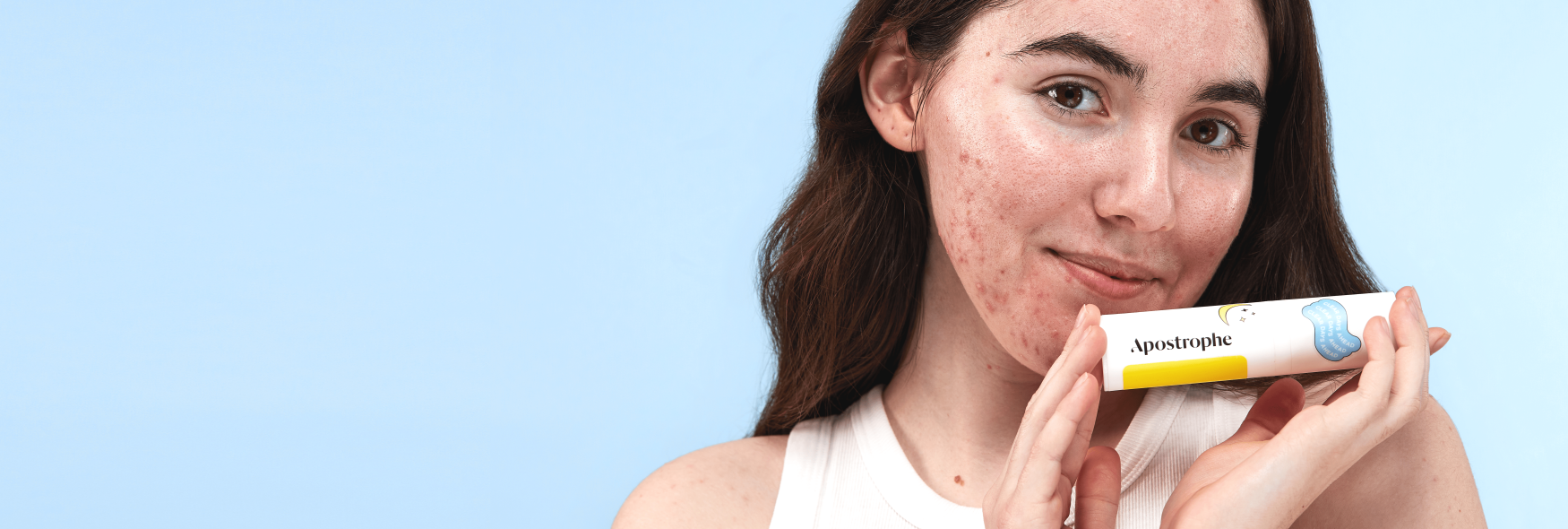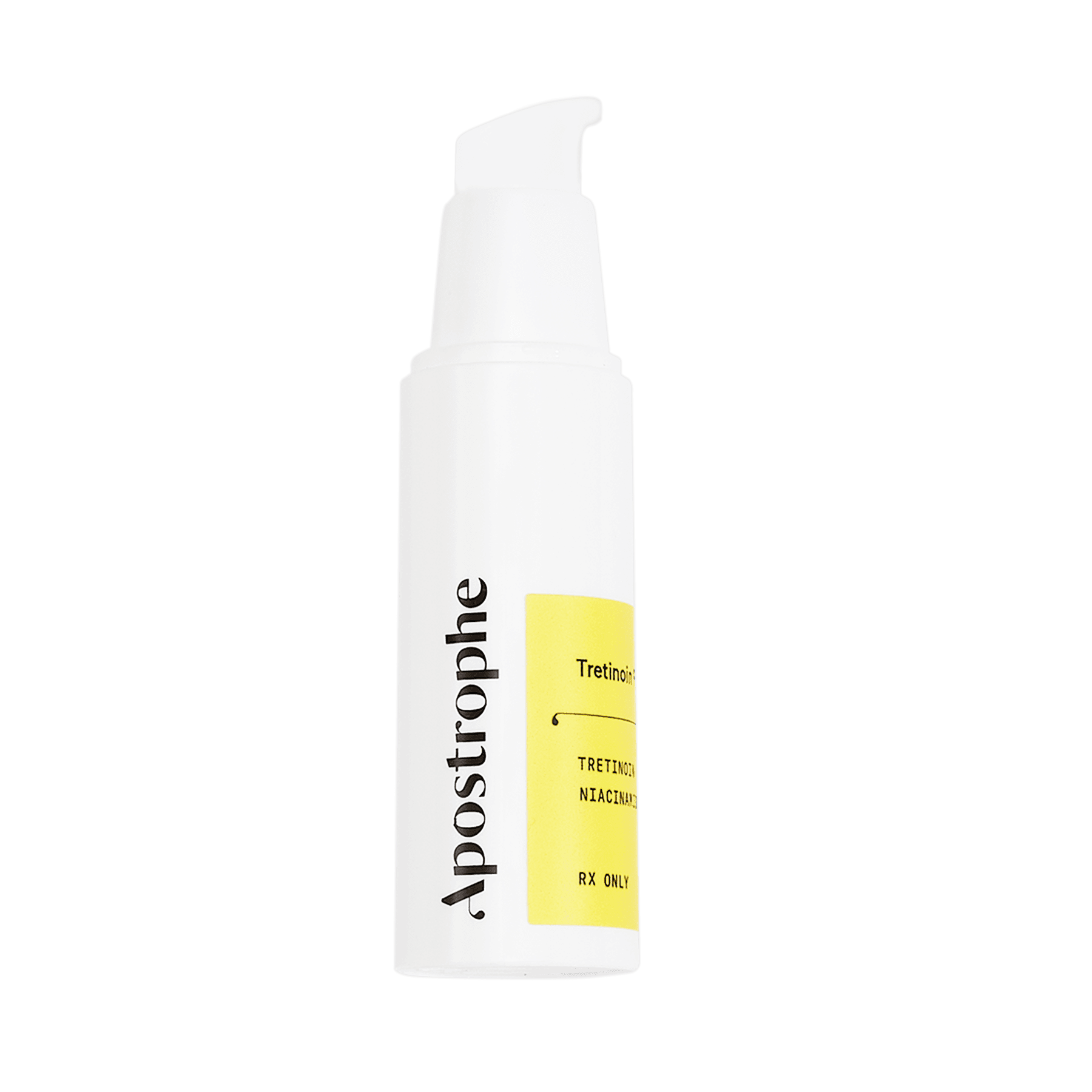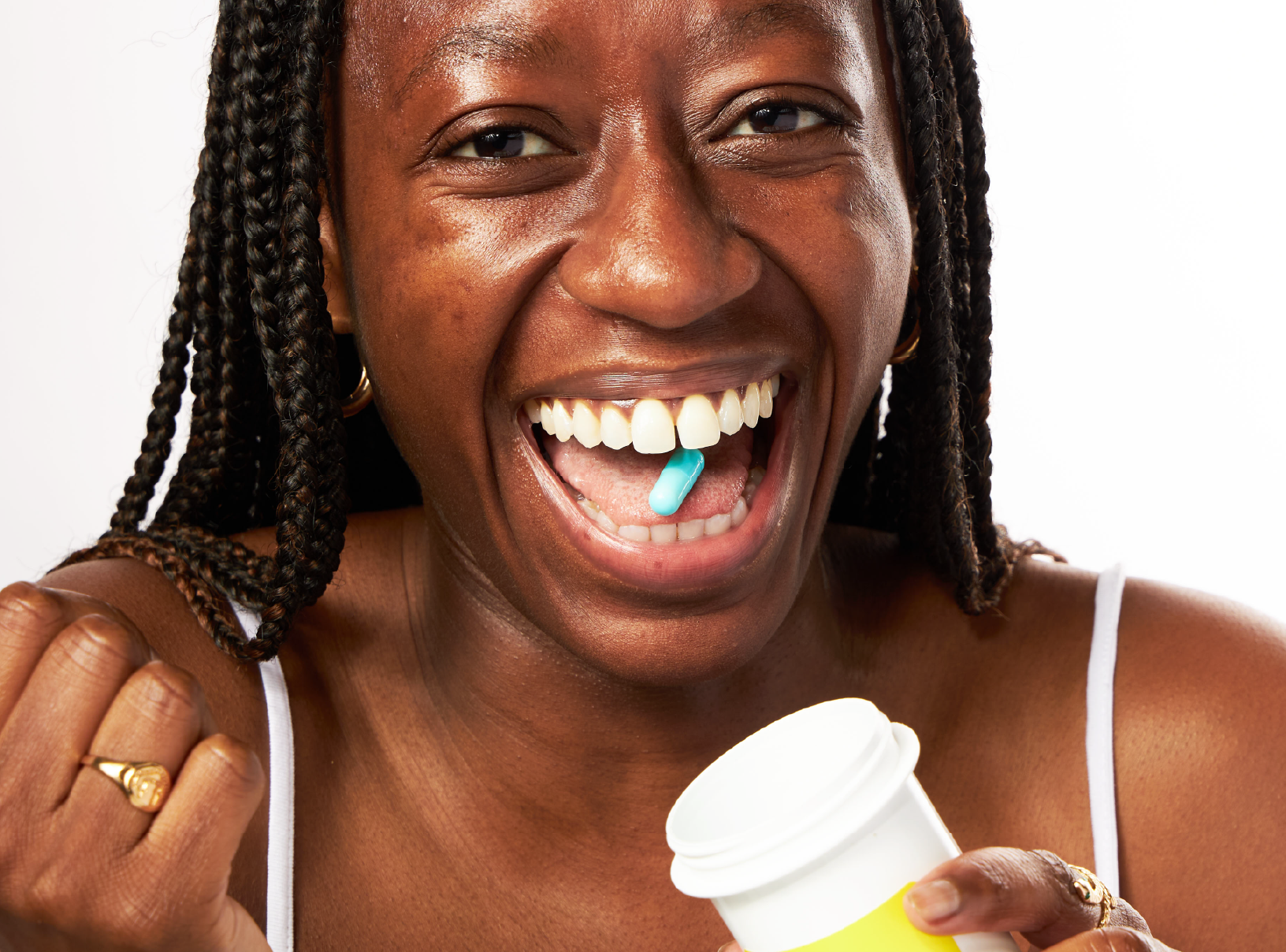Education
What is acne vulgaris?


SHARE
Education
What is acne vulgaris?
Medically reviewed by Vicky Davis, FNP
Written by Apostrophe Team
Last updated 11/1/2024
You probably started getting acne in middle school or high school and thought you’d grow out of it. Now, you’re rounding out your mid-twenties and wondering why the zits still won’t quit.
If acne is still killing your vibe, keep reading to find out what causes it, what the symptoms are, and treatment options to get rid of it once and for all.
What Is Acne Vulgaris?
Acne vulgaris (AV) is a common skin condition that causes noninflammatory lesions (blackheads and whiteheads), inflammatory lesions (papules, pustules, and nodules), and varying degrees of scarring. Basically, acne vulgaris is the scientific name for the condition we know colloquially as “acne.”
Acne vulgaris is a common condition with a lifetime prevalence of approximately 85 percent and occurs mostly during the teenage years.
However, as you’re probably already aware, AV can definitely still continue to pop up well into adulthood. In fact, AV has a 50.9 percent prevalence rate in women ages 20 to 29 years, and the cases taper off — but still exist — in women ages 40 to 49 years (26.3 percent).
Adult acne is more common in women than in men. In fact, some research indicates that female patients account for 66 percent of dermatology practitioner visits. Moreover, women older than 25 also account for one third of all dermatology office visits for acne.
What Causes Acne Vulgaris?
Four main things lead to the formation of acne lesions:
A buildup of keratin and dead skin cells in the follicle which leads to comedones
Increased and altered sebum production due to hormones (androgen)
Overgrowth of the P. acnes bacteria in the follicle
Various inflammation in the body
Genetics, a high glycemic-index diet — including chocolate and dairy — and lifestyle factors, such as smoking, can also contribute to the development of acne.
What are the Symptoms of Acne Vulgaris?
Acne in women can occur at any age and with varying degrees of severity. Female patients may more frequently develop acne lesions on the lower third of the face — particularly on the chin and jawline.
Acne lesions range from comedones (blackheads and whiteheads) to papules, pustules, cysts, and nodules.
Women with polycystic ovarian syndrome (PCOS) may experience acne vulgaris as a symptom of the condition. Other symptoms, such as hirsutism (excessive hair growth) or menstrual irregularities may also occur in conjunction with AV.
Treatment Options for Acne Vulgaris
The good news is that there are many treatment options available for acne vulgaris, for anyone struggling with mild acne to severe acne.
The first-line treatment options for mild to moderate AV include:
Topical benzoyl peroxide
Topical retinoids
Topical treatments are considered one of the mainstays for patients with mild-to-moderate acne. These topical agents are available over-the-counter and by prescription.
Benzoyl peroxide is commonly used for the treatment of acne and is available in a variety of strengths (2.5% to 10%) and formulations (cream, gel, wash, foam, gel, leave-on, and wash-off). Benzoyl peroxide breaks down the dead skin cells and keratin plugs in the follicle. Benzoyl peroxide is also an anti-inflammatory agent with antimicrobial properties.
A topical retinoid is often used when acne is mainly comedonal — aka mostly blackheads and whiteheads. Retinoids are comedolytic and work by dissolving the plug in the follicle. Retinoids are also anti-inflammatory and work in combination with other topical treatments for all acne variants.
Azelaic acid is another topical treatment that acts as a comedolytic, antimicrobial, and anti-inflammatory agent. Azelaic acid is a naturally occurring acid that is found in whole-grains such as wheat, rye and barley. It’s important to note, however, that azelaic acid should be used with caution in people with sensitive skin, as it can cause redness, burning and irritation.
For severe acne vulgaris, treatment options include:
Prescription-strength topical retinoids
Oral antibiotics
Oral isotretinoin
Given the rise in antibiotic resistance, the treatment of acne with only an oral antibiotic medication is strongly discouraged. Therefore, it is best to use antibiotics sparingly and in conjunction with other treatment methods.
Oral isotretinoin is FDA-approved for the treatment of severe AV but can also be used to treat patients with moderate acne that is either treatment-resistant or relapses quickly after discontinuation of oral antibiotics. Several studies have shown that treatment of acne with isotretinoin decreases sebum production, the number of acne lesions, and acne scarring.
Other alternative treatment options include an oral medication called spironolactone, which is typically taken in combination with an oral contraceptive medication for best results.
Takeaways
If adult acne is ruining your life, don’t fret — there are several treatment options that can help keep the pimples away. From benzoyl peroxide to topical retinoids and isotretinoin, there is a treatment option that’s right for you and your skin.
References:
Tan, A. U., Schlosser, B. J., & Paller, A. S. (2017). A review of diagnosis and treatment of acne in adult female patients. International journal of womens dermatology, 4(2), pp. 56–71. Retrieved from https://www.ncbi.nlm.nih.gov/pmc/articles/PMC5986265/
Bhate, K., & Williams, H. C. (2013). Epidemiology of acne vulgaris. The British journal of dermatology, 168(3), pp. 474–485. Retrieved from https://onlinelibrary.wiley.com/doi/full/10.1111/bjd.12149
Collier, C. N., Harper, J. C., Cafardi, J. A., Cantrell, W. C., Wang, W., Foster, K. W., & Elewski, B. E. (2008). The prevalence of acne in adults 20 years and older. Journal of the American Academy of Dermatology, 58(1), pp. 56–59. Retrieved from https://www.jaad.org/article/S0190-9622(07)01081-X/fulltext
Bataille, V., Snieder, H., MacGregor, A. J., Sasieni, P., & Spector, T. D. (2002). The influence of genetics and environmental factors in the pathogenesis of acne: a twin study of acne in women. The Journal of investigative dermatology, 119(6), pp. 1317–1322. Retrieved from https://www.jidonline.org/article/S0022-202X(15)30101-9/fulltext
Ismail, N. H., Manaf, Z. A., & Azizan, N. Z. (2012). High glycemic load diet, milk and ice cream consumption are related to acne vulgaris in Malaysian young adults: a case control study. BMC dermatology, 12, pp. 13. Retrieved from https://www.ncbi.nlm.nih.gov/pmc/articles/PMC3470941/
Magin, P., Pond, D., Smith, W., & Watson, A. (2005). A systematic review of the evidence for myths and misconceptions in acne management: diet, face-washing and sunlight. Family practice, 22(1), pp. 62–70. Retrieved from https://academic.oup.com/fampra/article/22/1/62/440463
Di Landro, A., Cazzaniga, S., Parazzini, F., Ingordo, V., Cusano, F., Atzori, L., Cutrì, F. T., Musumeci, M. L., Zinetti, C., Pezzarossa, E., Bettoli, V., Caproni, M., Lo Scocco, G., Bonci, A., Bencini, P., Naldi, L., & GISED Acne Study Group (2012). Family history, body mass index, selected dietary factors, menstrual history, and risk of moderate to severe acne in adolescents and young adults. Journal of the American Academy of Dermatology, 67(6), pp. 1129–1135. Retrieved from https://www.jaad.org/article/S0190-9622(12)00164-8/fulltext
Klaz, I., Kochba, I., Shohat, T., Zarka, S., & Brenner, S. (2006). Severe acne vulgaris and tobacco smoking in young men. The Journal of investigative dermatology, 126(8), pp. 1749–1752. Retrieved from https://www.jidonline.org/article/S0022-202X(15)33015-3/fulltext
Kamangar, F., & Shinkai, K. (2012). Acne in the adult female patient: a practical approach. International journal of dermatology, 51(10), pp. 1162–1174. Retrieved from https://onlinelibrary.wiley.com/doi/full/10.1111/j.1365-4632.2012.05519.x
Nast, A., Dréno, B., Bettoli, V., Degitz, K., Erdmann, R., Finlay, A. Y., Ganceviciene, R., Haedersdal, M., Layton, A., López-Estebaranz, J. L., Ochsendorf, F., Oprica, C., Rosumeck, S., Rzany, B., Sammain, A., Simonart, T., Veien, N. K., Zivković, M. V., Zouboulis, C. C., Gollnick, H., … European Dermatology Forum (2012). European evidence-based (S3) guidelines for the treatment of acne. Journal of the European Academy of Dermatology and Venereology : JEADV, 26 Suppl 1, pp. 1–29. Retrieved from https://onlinelibrary.wiley.com/doi/full/10.1111/j.1468-3083.2011.04374.x
Zaenglein, A. L., Pathy, A. L., Schlosser, B. J., Alikhan, A., Baldwin, H. E., Berson, D. S., Bowe, W. P., Graber, E. M., Harper, J. C., Kang, S., Keri, J. E., Leyden, J. J., Reynolds, R. V., Silverberg, N. B., Stein Gold, L. F., Tollefson, M. M., Weiss, J. S., Dolan, N. C., Sagan, A. A., Stern, M., … Bhushan, R. (2016). Guidelines of care for the management of acne vulgaris. Journal of the American Academy of Dermatology, 74(5), pp. 945–73.e33. Retrieved from https://www.jaad.org/article/S0190-9622(15)02614-6/fulltext
Agarwal, U. S., Besarwal, R. K., & Bhola, K. (2011). Oral isotretinoin in different dose regimens for acne vulgaris: a randomized comparative trial. Indian journal of dermatology, venereology and leprology, 77(6), pp. 688–694. Retrieved from https://ijdvl.com/oral-isotretinoin-in-different-dose-regimens-for-acne-vulgaris-a-randomized-comparative-trial/
Shop this post

Finacea (azelaic acid)
Like what you just read? Sign up for our email list to get the scoop on skincare science delivered straight to your inbox.

Deep Dives
A dermatologist shares his thoughts on the recent studies about benzoyl peroxide and benzene.
Read More
Education
What is milia?
What is milia? Today, we’re jumping into one type of bump that you may have heard about most commonly in infants — milia.
Read More
Education
Best moisturizer for acne-prone skin
If you have combination acne-prone skin, figuring out which moisturizer is best for your skin might be tough. In this guide, we break down the best moisturizer for combination, acne-prone skin.
Read More
